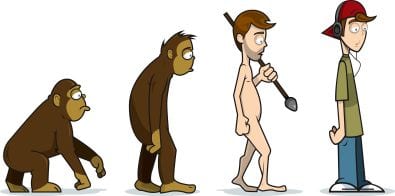
Almost since the 1871 publication of “The Descent of Man,” in which Charles Darwin applied his theory of natural selection to the human species, biologists have argued over whether the dramatic series of evolutionary events that led to the emergence of Homo sapiens continues to this day.
Modern Humans
Some have argued that culture and technology have eclipsed the powerful biological forces that shaped our species in its formative years. In their view the species, no longer faced with a daily struggle for survival, is adrift in an evolutionary Sargasso Sea.
“There’s been no biological change in humans in 40,000 or 50,000 years. Everything we call culture and civilization we’ve built with the same body and brain,” the famed evolutionary biologist Stephen J. Gould once said in an interview.
An Evolution Acceleration
In their new book “The 10,000 Year Explosion,” anthropologists Henry Harpending and Gregory Cochran argue the contrary position. They claim that in fact, far from grinding to a halt, human evolution has accelerated dramatically since the origins of agriculture about 10,000 years ago.
“We intend to make the case that human evolution has accelerated in the past 10,000 years, rather than slowing or stopping, and is now happening about 100 times faster than its long-term average over the 6 million years of our existence,” they write.
In evolutionary terms, 10,000 years is no time at all – about 400 human generations. Rabbits can go through 400 generations in not much more than a century – can you imagine rabbits being substantially different than they were 100 years ago?
Cognition
Far from ending the chain of dramatic evolutionary changes that led to upright walking, advanced cognitive abilities and spoken language, Cochran and Harpending argue, the adoption of agriculture so dramatically changed the human environment that a new wave of genetic innovations flourished.
These new genetic variants thrived because they helped people cope with the challenges an agricultural way of life presented, such as the shift to a low protein, high carbohydrate diet; the creation of an organized, stratified society and the rise of infectious diseases in response to increased population density.
In fact, many of the genetic variations that 23andMe provides information about are relics of those evolutionary changes. The SNP that confers lactose tolerance, for example, appears to have arisen in Europe about 8,000 years ago among the first people to herd cows and other milk-producing animals. The lactose-digesting variant quickly spread throughout the parts of Eurasia that were ecologically suited to pastoralism.
There are also a number of genetic variations covered by 23andMe that cause physiological problems when two mutated copies are present, but provide protection against infectious disease when a person has one of each version of the gene.
For example, the genetic variations that cause sickle cell anemia and G6PD deficiency confer resistance to malaria. Geneticists call this situation balancing selection; over the entire population, the reproductive cost to those who end up with the genetic disease is outweighed by the benefit to others who are resistant to the infectious one.
Natural Selection
At the end of the book, Cochran and Harpending make the controversial argument that balancing selection is responsible for the increased incidence of a number of genetic diseases among people of Ashkenazi Jewish descent – and for their higher intelligence relative to other groups.
The authors do raise some interesting points about the anomalously high frequency among Ashkenazi of genetic disorders that stimulate the growth of neurons in the brain. And they cite studies that have shown increased intelligence among people with some of these diseases.
But genetic explanations for between-group differences in intelligence are best taken with a whopping dose of skepticism. Even the definition of intelligence is a matter of intense debate, not to mention the degree to which it can be inherited through genetics. in the end, their case is little more than a just-so story.
In telling it Cochran and Harpending blunt the rest of their book’s powerful message: human evolution is not over by a long sight.


